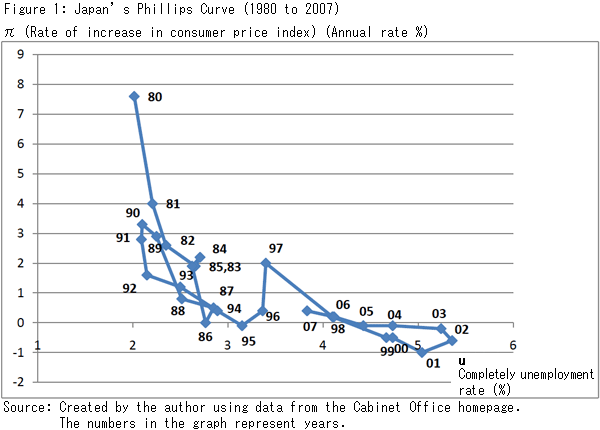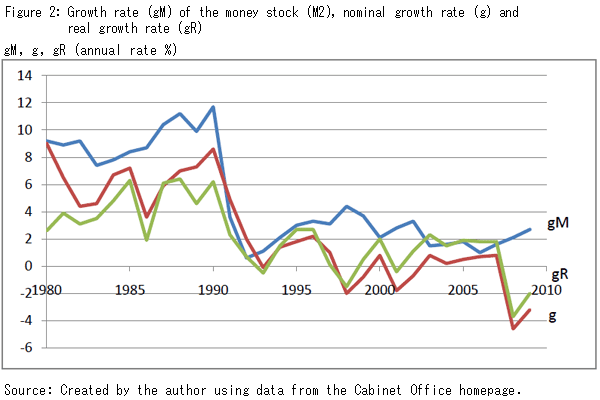Top>Research>Economic basis for the monetary policy of the new administration of President Abe
 Index
Index

Toichiro Asada [profile]
Education Course
Economic basis for the monetary policy of the new administration of President Abe
Toichiro Asada
Professor of Macroeconomics; Specialty in Macroeconomic Dynamics, Faculty of Economics, Chuo University
In the Lower House general election which was held on December 16th, 2012, the LDP (Liberal Democratic Party) led by President Abe increased its number of seats by 2.5 times when compared to before the election, thus capturing more than half the seats in the Lower House. The LDP plans to form a coalition government with the New Komeito Party, which would give the two parties more than two-thirds of the seats in the Lower House. This ensures that President Abe will become Prime Minister and lead the Japanese government for a second time. Prior to the election, the DPJ (Democratic Party of Japan) was the ruling party. However, in a crushing defeat, the seats held by the DPJ fell to one-fourth of the number prior to the election. The recent general election offered a variety of choices to voters, with a total of 12 different parties participating. Ultimately, the elimination of nuclear power and amendment of the Japanese constitution failed to become major issues in the election. Instead, attention was given to economic measures, especially monetary policy. As a result, the LDP won a major victory. According to current television reporting on public-opinion surveys, approximately half of voters placed the greatest priority on economic measures and employment measures when voting.
The manifest of President Abe's LDP for the recent election declared the following goals: "Clearly set an annual price escalation target (inflation target) of 2%, create a mechanism for strengthening the partnership between the government and Bank of Japan while considering amendment of the Bank of Japan Act, and seek to break away from deflation and a rising yen through bold monetary easing." Although similar measures have previously been proposed by Your Party, it was the first time that such measures have been directly released as a manifest by a major political party which has the high possibility of becoming the ruling party. As a result, monetary policy arose as a major issue for the first time in the history of Japan's general election. This is worthy of being noted as a revolutionary development. Although I do not personally support the LDP's nuclear power policy and proposal to amend the Japanese constitution, the monetary policy declared from before the general election by President Abe's administration is fundamentally correct and reasonable. Although the Bank of Japan has made absolutely no attempt to implement such monetary policy, it is nothing more than global standard monetary policy which is normally implemented by America's FRB and the central banks of advanced nations other than Japan. In this article, I will give a simple explanation for the economic basis of this monetary policy. To begin, let's examine macro data showing the performance of the Japanese economy from the 1990s to the 2000s, a period known as the "lost 20 years" in Japan.
Substance of the Japanese economy during the "lost 20 years"
Figure 1 shows Japan's Phillips curve for the 28-year period from 1980 until immediately before the subprime mortgage crisis in 2007. A Phillips curve represents the relationship between the unemployment rate and the rate of inflation (rate of increase in consumer price index). As shown in the figure, the 'completely unemployment rate' was at the 2% level during the 1980s, a period with a continued gentle annual inflation rate of about 2%. Conversely, the 'completely unemployment rate' was around 5% during the 2000s, a period when the rate of inflation fell to a gentle annual deflation rate of approximately -1%. Compared to the indexes used in Europe and America, Japan's 'completely unemployment rate' index is biased towards showing an extremely low unemployment rate. Differences aside, it is important to note that Japan's unemployment rate in the 2000s was nearly double the unemployment rate in the 1980s when measured using the same index. Furthermore, the rate of inflation increased by approximately 2% in the one-year period from 1996 to 1997. This increase reflected the fact that consumption tax was raised by 2% (from 3% to 5%) by the administration of Prime Minister Hashimoto. In effect, this furthered the worsening of the subsequent deflationary slump.

As shown, the Japanese economy during the 2000s fell into long-term stagnation associated with a gentle and sustained decrease in prices (deflation) of around 1% annually. The increase in the unemployment rate was not the only index which changed during this process of deflation. Figure 2 shows the growth rate of nominal GDP (nominal growth rate), an index which shows the gross income of citizens as measured in money, and the growth rate of real GDP (real growth rate), an index for the real economic affluence of citizens. It can be seen that both of these rates decreased while moving closely in conjunction. As shown, even gentle annual deflation of around 1% has a serious impact on the nominal income of citizens, the real income of citizens, and the unemployment rate.

Primary cause of deflationary depression
What is the main cause of the deflationary depression which continued in Japan for 20 years? The answer is the extremely inactive monetary policy of the Bank of Japan which continued for a 20-year period. This conclusion cannot be refuted as long as we recognize the following fact: "In the mid- to long-term, the growth rate of money existing in a certain nation has the greatest impact on the inflation rate of that nation. The only institution with the ability and authority to control the growth rate of money is the central bank of that nation."
As shown by Professor Yoichi Takahashi (Kaetsu University), there is a close statistical relationship between the inflation rate and the growth rate of the money stock in each county. In the 2000s, both the inflation rate and money stock growth rate of Japan were extremely low when compared to other countries in the same period (refer to Related Literature [2]). The same fact can be confirmed by looking at Figure 2. The figure shows that during the past 30 years of the Japanese economy, the nominal growth rate (g) and the real growth rate (gR) have moved in extremely close conjunction with the growth rate (gM) of the money stock (M2). Additionally, the difference between g and gR (g - gR) in this figure shows the rate of increase in the GDP deflator (the inflation rate measured by a certain type of index). In other words, g is greater than gR during periods of inflation, while g is less than gR during periods of deflation. This figure shows that, in the 1980s, an average annual money stock growth rate of approximately 10% supported an average annual nominal growth rate of approximately 6%, an average annual real growth rate of approximately 4% and an average annual inflation rate of approximately 2%. Conversely, from 1990 to 1993, it can be seen that there was a rapid decrease in the nominal growth rate and the real growth rate which decrease was triggered by a rapid decrease in the money stock growth rate due to monetary tightening that was implemented by the Bank of Japan with the intention of suppressing the economic bubble. Furthermore, as shown in Figure 1, the inflation rate fell and the unemployment rate increased during this process. For about a 20-year period beginning from the 1990s, the Bank of Japan suppressed the money stock growth rate to an annual rate of around 2%. This was only one-fifth of the growth rate during the 1980s. As a result, the average nominal growth rate was an annual rate of about -0.7%, the average real growth rate was an annual rate of about 0.6%, and the average inflation rate was an annual rate of about -1.3%.
In other words, the extremely inactive monetary policy by the Bank of Japan established a deflationary slump 20 years. In Figure 2, the falling economy in 1997 was due to the increase in consumption tax, while the rapid decline in 2008 was due to the global financial crisis triggered by the subprime mortgage crisis starting in America. Excluding these declines which were caused by factors other than the Bank of Japan's monetary policy, changes in the money stock show a time lag of about 1 to 2 years while following changes in the nominal growth rate and real growth rate.
The highest nominal GDP ever recorded by Japan was 521 trillion yen in 1997. Even in 2010, a year in which the Japanese economy had yet to be affected by the 2011 Great East Japan Earthquake, the nominal GDP had declined to 480 trillion yen, a decrease of 41 trillion yen when compared to 1997. If Japan's nominal GDP had continued to grow from 1997 at the annual rate of 4% which is the average for OECD countries, Japan's current nominal GDP would be about 900 trillion yen. In such a case, Japan would be free from currently developing problems such as the shortage of tax revenue, rapid increase in the ratio of government debt to GDP, and shortages of financial resources for social insurance and social security. The Ministry of Finance would then have no pretense for raising consumption tax.
Regarding rising yen deflation and mistakes in the declining population deflation hypothesis
Some parties (including the Bank of Japan, a directly interested party) insist that the Bank of Japan's monetary policy is not responsible for deflation. They tend to assert that the inflation rate is mainly decided by something other than money; in other words, something other than the monetary policy of a central bank. Most influential is the declining population deflation hypothesis (refer to Related Literature [4]) disseminated by Kosuke Motani (Senior Counselor to the Development Bank of Japan). This hypothesis states that deflation is caused by the decreased birthrate and aging population due to a declining population. This hypothesis was even used in a lecture given by the Bank of Japan Governor Masaaki Shirakawa. However, there is actually no relationship between the inflation rate and population growth rate of countries. This has been indicated based on statistical data by Professor Kikuo Iwata (Gakushuin University) and Yoichi Takahashi (refer to Related Literature [1] and [2]).
Lastly, I would like to consider the theory that deflation is caused by a rising yen. It is true that a rising yen causes a decrease in domestic prices for imported goods, which in turn encourages deflation. However, as pointed out by Koichi Hamada (Professor Emeritus, Yale University), according to the monetary approach of international financial theory, mid- to long-term fluctuations in the exchange rate are caused by the relative ratio of the monetary stock existing in countries. In other words, the currency of a country which has increased (decreased) its money stock relative to another country will fall (rise) relatively when compared to the currency of other countries. There is empirical support for this theory. That is, the cause of a rapidly rising yen following the 2008 subprime mortgage crisis is that the Bank of Japan's monetary easing was extremely insufficient when compared to the central banks of other countries (particularly America) (refer to Related Literature [3]). Ultimately, the cause of deflation and the cause of a rising yen is the same.
According the Yomiuri Shimbun Newspaper published on December 17th, the day after the general election, Koichi Hamada was appointed as Special Advisor to the Cabinet (Economic Advisor) in order to advise the new Cabinet on deflation and economic measures. I expect professor Hamada to fulfill an important role in the monetary policy of President Abe's administration, which is considering amending the Bank of Japan Act.
Related Literature
- [1] Kikuo Iwata (2012) "Bank of Japan: Guardian of Deflation" (Nikkei Shimbun Publishing)
- [2] Yoichi Takashi (2012) "Using Graphs to Understand the Deep Layers of Japan" (Kodansha Publishing)
- [3] Koichi Hamada, Masazumi Wakatabe & Kazuyo Katsuma (2010) "Learn from Legend! The True Meaning of Economics" (Toyo Keizai Shinpo Publishing)
- [4] Kosuke Motani (2010) "The Identity of Deflation-The Economy Moves Through Population Waves (Kadokawa Shoten Publishing)
- Toichiro Asada
Professor of Macroeconomics; Specialty in Macroeconomic Dynamics, Faculty of Economics, Chuo University -
Current Position: Professor, Faculty of Economics, Chuo University
Born in 1954 in Aichi Prefecture. In 1977, graduated from the Waseda University School of Political Science and Economics. In 1982, completed the Doctoral Program at the Hitotsubashi University Graduate School of Economics. Holds a PhD in economics from Chuo University. Served at Associate Professor at the Komazawa University Department of Economics and as Associate Professor at the Chuo University Faculty of Economics before assuming his current position in 1994. His current research themes are economic fluctuations and macroeconomic policy based on macroeconomic dynamics methods. His major written works include "Macrodynamics of Growth and Cycles" (Nihon Keizai Hyoronsha Publishing, 1997; written alone) and "Monetary Macrodynamics" (Routledge, London, 2010; co-written).
- Research Activities as a Member of Research Fellowship for Young Scientists (DC1), Japan Society for the Promotion of Science (JSPS) Shuma Tsurumi
- Important Factors for Innovation in Payment Services Nobuhiko Sugiura
- Beyond the Concepts of Fellow Citizens and Foreigners— To Achieve SDGs Goal 10 “Reduce Inequality Within and Among Countries” Rika Lee
- Diary of Struggles in Cambodia Fumie Fukuoka
- How Can We Measure Learning Ability?
—Analysis of a Competency Self-Assessment Questionnaire— Yu Saito / Yoko Neha - The Making of the Movie Kirakira Megane








